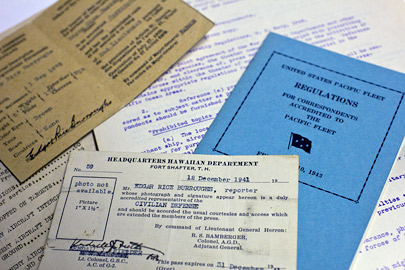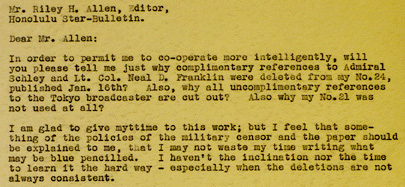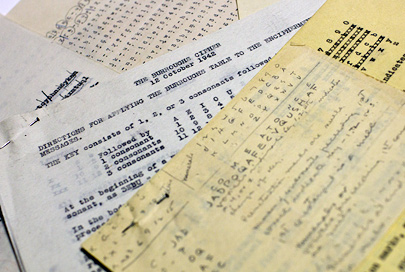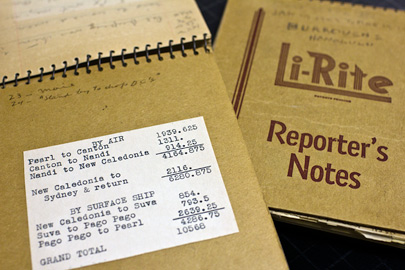World War II

Pearl Harbor
Edgar Rice Burroughs arrived in Hawaii in April, 1940, with the dark clouds of war building on the western horizon. While he was still a prolific writer, often working on several books at once, his personal life became troubled as his second marriage began to fall apart and his health problems increased. The attack on Pearl Harbor in 1941, eye-witnessed and reported on by Burroughs himself, quickly pushed aside this malaise.

Burroughs immediately volunteered his service in the war effort and was accepted as a war corespondent, one of the war's oldest. Just 5 days after the attack, Burroughs began writing a column for the Honolulu Advertiser and Star-Bulletin called "Laugh It Off." Intended as a morale booster, the column featured humorous stories detailing the trials and tribulations of living in Martial Law Hawaii, where blackouts, rationing and curfews were mandatory throughout the war. But Burroughs quickly became fatigued with military censors stripping what he considered the substance from his columns and, feeling he could make a greater impact elsewhere, he moved on from "Laugh It Off" in early 1942.

The Nisei
Burroughs then became the public relations officer for The Businessmen's Military Training Corps, a civilian home defense organization. The creation of the BMTC was partly in response to the fear among many whites on the island that the Japanese Hawaiians, or Nisei, would rise up and fight for Japan. At the time Burroughs saw this threat as a grave concern and took his duties with the BMTC seriously at first, but grew ever more frustrated by the lack of support and respect the group received from the regular army.

Over the course of his war writing there is an evident shift in Burroughs' viewpoint of the Nisei. The suspicion and prejudices exhibited by Burroughs at the war's beginning were, by 1943, replaced by a more reasoned reappraisal of the Japanese Hawaiians, which earned him praise from many Nisei civic leaders. The refutation of his past opinions were expressed in a candid article for the magazine Hawaii published June 30, 1944.

United Press
Burroughs resigned from the BMTC in September, 1942, and applied to be a war correspondent for United Press. He was approved in November, and for much of the rest of the war undertook a series of tours of various war zones in the South Pacific. Burroughs logged thousands of miles traveling from island to island, in planes and on ships, joining bomber crews on missions, writing dozens of stories for UP, many of which, much to his dismay, were suppressed. As the war drew to a close, Burroughs reinstated his "Laugh It Off" column, which reported on the death of FDR and V-E day.
